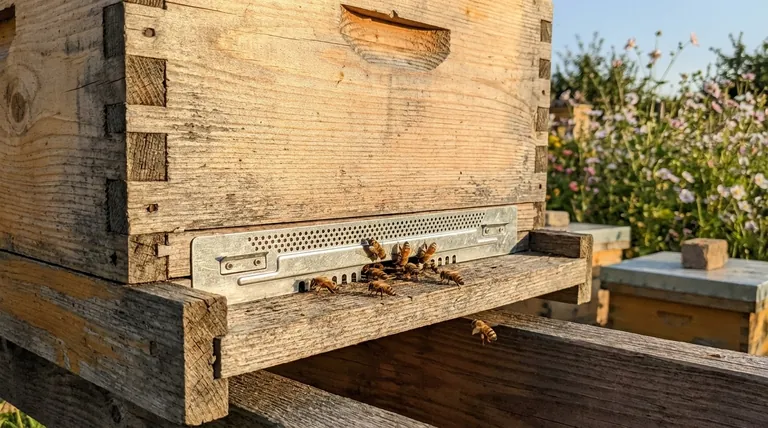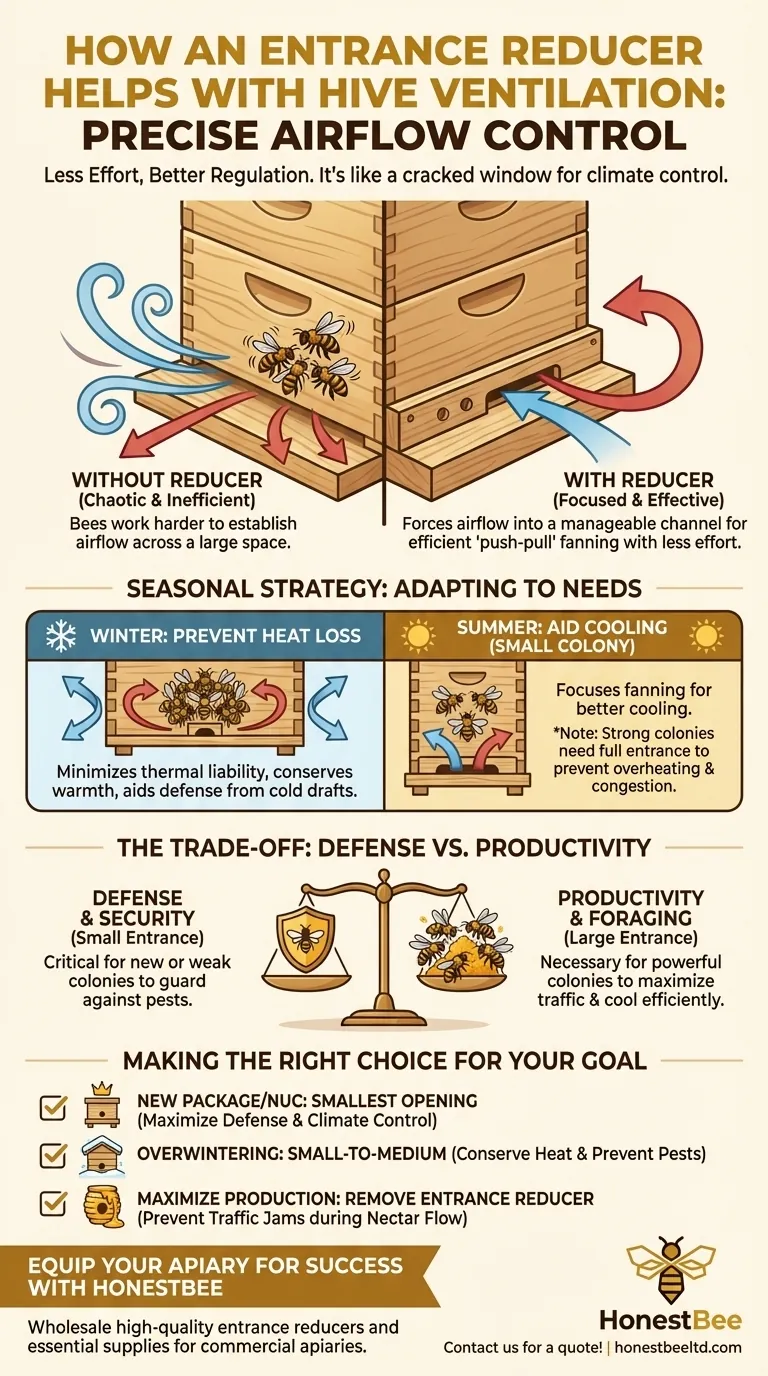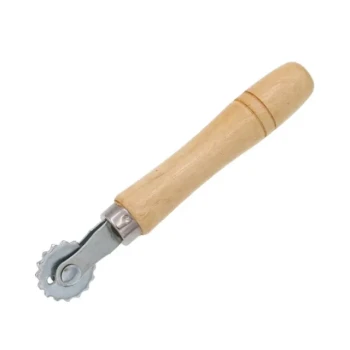At its core, an entrance reducer helps with hive ventilation by giving the honey bee colony precise control over airflow. Rather than simply maximizing ventilation, it creates a smaller, more manageable opening. This allows the bees to efficiently regulate their internal temperature and humidity with far less effort, similar to how a small, cracked window allows for better temperature control in a room than a wide-open door.
A hive's entrance is both its greatest asset for foraging and its greatest liability for defense and climate control. An entrance reducer is the beekeeper's tool to manage this liability, transforming a large, vulnerable opening into a defensible and environmentally stable gateway for the colony.

The Physics of Hive Airflow
A honey bee hive is a living system that must actively manage its internal environment. The entrance is the primary interface for this exchange, serving as the hive's mouth, lungs, and front door all at once.
Ventilation as an Active Process
Honey bees ventilate their hive by fanning their wings. Some bees at the entrance will face the hive and fan to draw fresh air in, while others face away and fan to push stale, warm, and humid air out. This creates a circular air current.
A massive, wide-open entrance makes this an inefficient, energy-intensive process. The bees must work much harder to establish a stable current across a large, undefined space.
The Principle of Controlled Airflow
An entrance reducer constricts the opening, forcing the airflow into a predictable, manageable channel. This allows the fanning bees to create a strong, focused air current with much less effort.
Think of it as the difference between trying to cool a warehouse with a single fan versus using that same fan in a narrow hallway. In the hallway, the airflow is concentrated and effective.
Seasonal Ventilation Strategy
The need for ventilation control changes dramatically with the seasons. Using an entrance reducer is not a year-round requirement but a strategic intervention.
Preventing Heat Loss in Winter
During winter, the colony forms a tight cluster to generate and conserve heat. A large entrance becomes a massive thermal liability, allowing precious warmth to escape and cold drafts to enter.
By reducing the entrance to its smallest setting, you minimize this heat loss. The bees can more easily guard the opening from cold air and maintain the stable temperature required for survival.
Aiding Cooling in Summer
This seems counterintuitive, but a reducer can also help with cooling under specific circumstances, particularly for a smaller colony. By focusing their fanning efforts, the bees create a more efficient "push-pull" ventilation system.
However, for a very strong, populous hive in the peak of summer, a full-sized entrance is often necessary to prevent overheating and allow for the heavy traffic of foraging bees.
Understanding the Trade-offs
Using an entrance reducer is a balancing act. While it provides control and defense, improper use can create new problems. The key is to adapt its use to the colony's specific strength and the current season.
The Risk of Overheating and Congestion
For a strong, booming colony during a summer nectar flow, an entrance reducer can be a major liability. The restricted opening can create a "traffic jam" for foragers, slowing honey production.
More critically, it can limit the bees' ability to ventilate, leading to overheating. This is often signaled by "bearding," where a large number of bees cluster on the outside of the hive to escape the internal heat.
Defense vs. Foraging Efficiency
The primary trade-off is between security and productivity.
A small entrance is easy to defend, which is critical for a new, small, or weak colony that could be overwhelmed by wasps or robbing bees. For them, survival is the priority.
A large entrance is necessary for a powerful colony to maximize the flow of foragers and efficiently cool the hive. For them, productivity is the priority.
Making the Right Choice for Your Goal
The entrance reducer is not a "set it and forget it" tool. It's an instrument you adjust based on the needs of your colony.
- If your primary focus is establishing a new package or nuc: Use the smallest opening to maximize defense and help the small colony easily control its climate.
- If your primary focus is overwintering a colony: Use a small-to-medium opening to conserve heat, provide ventilation, and prevent mice from entering the hive.
- If your primary focus is maximizing honey production with a strong hive: Remove the reducer entirely during the main nectar flow to prevent traffic jams and allow for maximum ventilation.
Observing your hive and understanding its needs is the key to using this simple tool effectively.
Summary Table:
| Function | Benefit | Ideal Use Case |
|---|---|---|
| Controls Airflow | Creates a focused, efficient air current for easier bee fanning. | All seasons, especially for smaller colonies. |
| Prevents Heat Loss | Minimizes drafts and helps the winter cluster conserve energy. | Overwintering colonies. |
| Aids Defense | Creates a smaller, easily guarded entrance against pests and robbers. | New, weak, or small colonies. |
| Manages Traffic | Prevents forager congestion when used appropriately. | Varies by colony strength and season. |
Ready to equip your apiary with the right tools for success? Proper ventilation management is key to a thriving colony. At HONESTBEE, we supply commercial apiaries and beekeeping equipment distributors with the durable, high-quality entrance reducers and other essential supplies needed to support healthy, productive hives. Let our wholesale-focused expertise help your operation flourish. Contact our team today to discuss your needs and request a quote!
Visual Guide

Related Products
- Beehive Entrance Reducer Guardian Metal Hive Entrance for Bees
- Multi-Functional Sliding Hive Entrance for Beekeeping
- Multi-Functional Rotary Hive Entrance Disc for Beekeeping
- HONESTBEE Professional Multi-Functional Hive Tool with Ergonomic Wood Handle
- HONESTBEE Advanced Ergonomic Stainless Steel Hive Tool for Beekeeping
People Also Ask
- How can a Langstroth hive entrance be adjusted? Mimic Natural Bee Preferences for a Healthier Hive
- How big should a beehive entrance be? Optimize for Colony Health & Honey Production
- What happens if you seal an entrance to a bee hive? Avoid a Costly Structural Disaster
- What is the purpose of placing an object in front of the hive entrance after a move? A Guide to Forced Reorientation
- What are the different types of entrance reducers available? A Guide to Protecting Your Hive



















